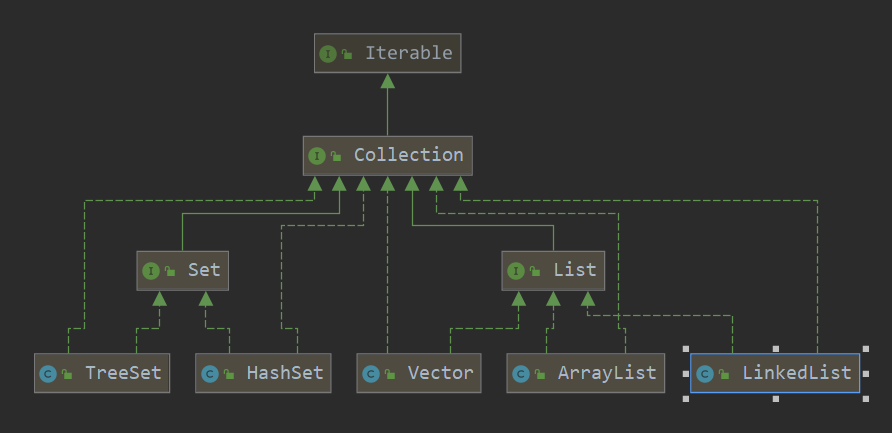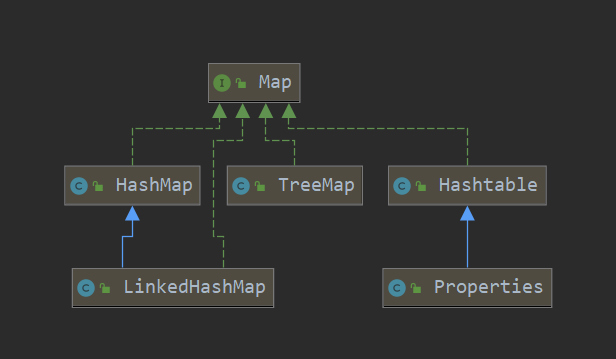Work hard and see you at the top! come on.
1, Set system diagram


2, Collection class
1. Characteristics of Collection interface implementation class
public interface Collection<E> extends Iterable <E>
- The Collection implementation subclass can store multiple elements, and each element can be an Object.
- Some Collection implementation classes can store duplicate elements, while others cannot.
- Some Collection implementation classes are ordered (List), and some are not ordered (Set).
- The Collection interface does not directly implement subclasses, but is implemented through its sub interfaces Set and List.
2. Collection common methods
- Add: add a single element
- remove: deletes the specified element
- contains: find whether the element exists
- size: get the number of elements
- isEmpty: judge whether it is empty
- Clear: clear
- addAll: add multiple elements
- contains: find whether multiple elements exist
- removeAll: delete multiple elements
3. Collection interface - Iterator interface
The Collection interface traverses the elements in 1 --- > using the Iterator iterator
- The Iterator object is called an Iterator and is mainly used to traverse the elements in the Collection
- All Collection classes that implement the Collection interface have an iterator() method to return an object that implements the Iterator interface, that is, an Iterator can be returned.
- Structure of Iterator
- The Iterator is only used to traverse the collection, and the Iterator itself does not store objects.
Implementation principle of iterator
Iterator iterator = coll.iterator();//Get an iterator for a collection
while(iterator.hasNext()){//Move down to return the elements at the collection position after moving down
System.out.println(iterator.next());
}
After calling iterator.next(); Method should be detected by using iterator.hasNext(). If not, when the next record is invalid, calling iterator.next() directly will throw NoSuchElementException.
Example of Iterator iterator usage:
import java.util.ArrayList;
import java.util.Collection;
import java.util.Iterator;
public class Iterator_Learn {
public static void main(String[] args) {
Collection col=new ArrayList();//col is compiled as Collection and run as ArrayList
//Upward transformation is used here
col.add(new Book("Romance of the Three Kingdoms",10));
col.add(new Book("Water Margin",20));
col.add(new Book("Journey to the West",15));
Iterator iterator=col.iterator();//Get an iterator
while(iterator.hasNext()){
Object next = iterator.next();
System.out.println(next);
}
//Reset iterator position
iterator=col.iterator();
}
}
class Book{
String name;
double price;
public Book(String name, double price) {
this.name = name;
this.price = price;
}
@Override
public String toString() {
return "Book{" +
"name='" + name + '\'' +
", price=" + price +
'}';
}
}
Shortcut prompt:
Generate iterator: itit
Show shortcuts for all shortcuts: Ctrl+j
Method 2 of traversing elements through the Collection interface - > using the enhanced for loop, the bottom layer is still the iterator
for(Element type element name: Collection name or array name){
Access element
}
//Example
for(Object book:col){
System.out.println("book="+book);//book is created in the enhanced for loop to read the element.
}
3, List class
The List interface is a sub interface of the Collection interface
- The elements in the List collection class are orderly (that is, the addition order is consistent with the extraction order) and the elements can be repeated.
- Each element in the List collection has its corresponding sequential index, that is, it supports index.
- The elements in the List container correspond to an integer serial number, recording their position in the container. You can get the elements in the container as needed.
- The common implementation classes of List interface in JDK API are ArrayList, LinkedList and Vector.
import java.util.ArrayList;
import java.util.List;
public class List_ {
public static void main(String[] args) {
List list=new ArrayList();
list.add("jack");
list.add("tom");
list.add("mary");
list.add("hsp");
System.out.println("list"+list);
System.out.println(list.get(3));//2. Each element in the list set has its corresponding sequential index, that is, it supports index.
}
}
List interface and common methods
Some methods are added to the List collection to manipulate the collection elements according to the index
- void add(int index,Object ele); Insert the ele element at the index position.
- boolean addAll(int index,Collection eles); Add all elements in eles from the index position.
- Object get(int index) gets the element at the specified index position.
- int indexOf(Object obj); Returns the position where obj first appears in the collection.
- int lastIndexOf(Object obj); Returns the last occurrence of obj in the current collection.
- Object remove(int index); Removes the element at the specified index location and returns this element.
- Object set(int index,Object ele); Set the element at the specified index position to ele, which is equivalent to replacement.
- List subList(int fromIndex,int toIndex); Returns a subset from fromindex to toindex. (front closed and rear open)
- Three traversal modes of List: ① iterator ② enhanced for loop (the bottom layer is also iterator) ③ ordinary for loop
**Exercise procedure: * * sort the collection according to the book price.
import java.util.ArrayList;
import java.util.Iterator;
import java.util.List;
public class ListExercise {
public static void main(String[] args) {
List list= new ArrayList();
Book book1=new Book("The Dream of Red Mansion",20);
Book book2=new Book("Journey to the West",90);
Book book3=new Book("Romance of the Three Kingdoms",30);
Book book4=new Book("Water Margin",80);
list.add(book1);
list.add(book2);
list.add(book3);
list.add(book4);
Iterator iterator=list.iterator();
while (iterator.hasNext()){
Book book=(Book)iterator.next();
System.out.println(book);
}
sort(list);
System.out.println("-----After sorting-----");
iterator=list.iterator();
while (iterator.hasNext()){
System.out.println(iterator.next());
}
}
public static void sort(List list){
int size = list.size();
for (int i = 0; i < size-1; i++) {
for (int j = 0; j < (size-1-i); j++) {
// Object book1=list.get(j);// Here, you use object to receive objects, but you can't call the special functions in the Book class
// Object book2=list.get(j+1);
Book book1=(Book)list.get(j);
Book book2=(Book)list.get(j+1);
if (book1.getBookPrice()>book2.getBookPrice()){
list.set(j,book2);
list.set(j+1,book1);
}
}
}//End of cycle
}
}
class Book{
String bookName;
double bookPrice;
public Book(String bookName, double bookPrice) {
this.bookName = bookName;
this.bookPrice = bookPrice;
}
public String getBookName() {
return bookName;
}
public void setBookName(String bookName) {
this.bookName = bookName;
}
public double getBookPrice() {
return bookPrice;
}
public void setBookPrice(double bookPrice) {
this.bookPrice = bookPrice;
}
@Override
public String toString() {
return "Book{" +
"bookName='" + bookName + '\'' +
", bookPrice=" + bookPrice +
'}';
}
}